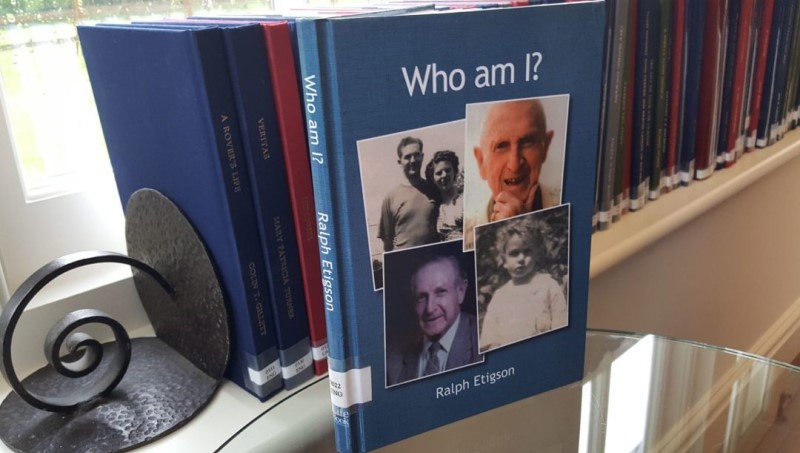Ralph Etigson is currently LifeBook’s second-oldest author, after Frank Bisby, aged 104

The LifeBook team was delighted to wish Ralph Etigson a very happy birthday recently by gifting the centenarian two new handmade copies of his autobiography, Who am I?.
Ralph, who has just turned 102, was thrilled to receive his books, and he particularly enjoyed reminiscing while looking through the book’s photos.
Ralph’s autobiography – one of LifeBook’s first projects – was originally completed in 2012.
He has an interesting journey that influenced LifeBook’s founder Roy Moëd’s exploration of the effects of autobiography projects in elder adults.
Baycrest Research
Ralph’s project was part of a two-year research initiative that focused on the best way to create autobiographies in a manner that is both enjoyable and therapeutic. It was carried out by Baycrest’s research arm in their Retirement Residence in Ontario, Canada, where Ralph still resides. He was one of two residents who participated in the study.
Baycrest specialises in long-term senior care, forming part of the Baycrest Health Sciences family and campus. Affiliated with the University of Toronto and already well known for its focus on age-related brain health research, Baycrest was the perfect place in which Roy and his team could explore how autobiography projects can have positive effects on slowing down cognitive decline, improving self-worth and general wellbeing in elders.
Roy’s joint initiative with Baycrest directly resulted in the development of LifeBook. The methods established in the study went on to form the basis of the interviewer selection and training, and the way in which LifeBook’s projects are structured – only made possible by the breakthrough in deconstructing the interviewer from the writer.
Just a few years later, LifeBook has used the same methods to produce nearly 1000 personal autobiographies in various languages across the world.
How the Study Worked
Baycrest researchers were trained and used as interviewers who met Ralph and another resident for several separate interviewing sessions. Recordings from these sessions were used by LifeBook’s ghostwriters to create their autobiographies, while their feedback, along with that of the researchers, was monitored throughout the projects.

“The research helped create the understanding that regular interventions help slow down cognitive decline in elder adults,” recalls Roy. The experience also had positive outcomes for the authors’ self-worth, memory, sense of control and, ultimately, their overall wellbeing. Both residents looked forward to their interview sessions and enjoyed the control that reviewing their manuscripts gave them, as well as the sense of control that being in charge of their projects afforded them. The sessions became a significant highlight in their lives; the satisfaction was as much in the process as it was with the finished book.
In the study, one of the authors was introverted while the other was extroverted. Both had exactly the same number of interviews. “There was little or no disparity with the length of their books, which was a huge, but pleasant, surprise to us,” says Roy. This turned out to be the result of well-structured interviewing and showed the growing therapeutic benefit enjoyed by the authors. The interviewing structure formed the basis of the interviewer training at LifeBook.
Baycrest Conclusion
“The research successfully backed up the original idea that I had had from my own father’s experience: projects such as these result in a number of undeniable positive effects for participants,” Roy says. “It resulted in my much deeper understanding of this topic, coupled with the validation to expand LifeBook as a social business (commercial business in a social space). We remain grateful to have been able to work with Baycrest to make this happen.”
The Baycrest study led to not only two completed projects and two contented authors, but also to Roy further developing LifeBook and thereby transforming thousands of lives, which LifeBook continues to do every day.

